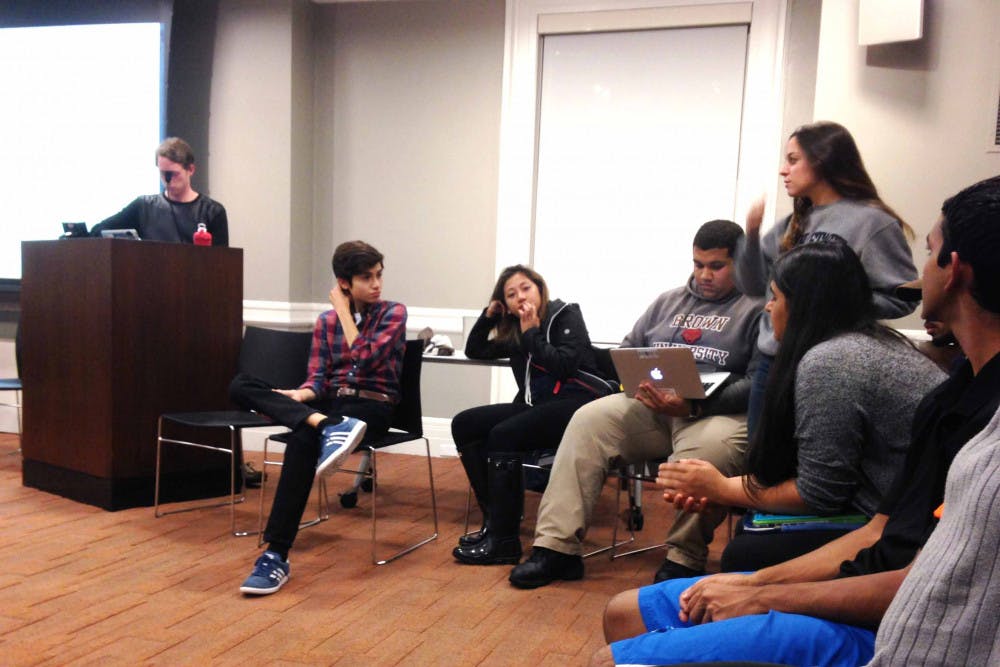President Christina Paxson P’19 emphasized the importance of investment in students, faculty and staff in a discussion of the “BrownTogether” comprehensive campaign with the Undergraduate Council of Students Wednesday.
“When I think about a university, I know that the most important thing is the people who are here and how brilliant, interesting and diverse they are,” Paxson said. “Infrastructure and programs that bring in talented staff members” as well as support for faculty and students will ensure the success of the University, she said.
Brown is substantially lacking in comparison with peer institutions when it comes to endowed chairs. Only 16 percent of faculty salaries are supported by endowed chairs — far lower than at many peer institutions, Paxson said.
The $1 billion goal for the “people” portion of the campaign includes funds for the creation of 115 endowed chairs, which range in cost from $2 million for an assistant professorship to $5 million for a University professorship.
“The market for faculty is very competitive,” Paxson said, noting that an endowed chair position is considered an “honor” at many universities. The introduction of more endowed chairs will boost Brown’s ability to recruit talented faculty, she said.
In regards to another section of the campaign that focuses on campus development, Paxson said building new structures is not a priority.
“We didn’t want to have a campaign that focused on bricks and mortar,” she said. “Our goal is to renovate where we can renovate and build only when we have to build.”
Ryan Lessing ’17, UCS community relations liaison, asked about prioritization of renovation and construction of dormitories, noting student support for renovation of specific residence halls.
In response, Paxson said the topic of new dormitories will be addressed following the conclusion of a longer-term conversation regarding growth in the student body size. Renovations will not likely be supported by the campaign, unlike other development initiatives, specifically the construction of a new engineering building and a performing arts center, she said. The University broke ground on the $88 million, 80,000-square-foot engineering building Oct. 22.
While alums expressed approval of recent renovations of “upper Pembroke dormitories” and Keeney Quadrangle, few have voiced willingness to donate to additional dorm renovation projects, Paxson said.
In a discussion on improvements to financial aid, Paxson noted a disconnect between alumni perceptions of the need for financial aid and the realities for current students. “A lot of alums think, ‘We’re need-blind; we’re done with that,’” she said. The University’s ultimate long-term goal is to meet the full financial need of every student, and alums should be encouraged to donate to support this goal from the moment they graduate, she added.
A way to connect with younger alums is to tailor fundraising efforts to individuals who belonged to specific organizations on campus, Paxson said. “We want to connect alums back into clubs that were important to them,” she said.
Austin Lessin ’19, UCS parliamentarian, asked how the campaign affects current students. The Brown Annual Fund, which finances many of the University’s day-to-day operations, has the most direct impact, Paxson said in response. The campaign includes a $400 million fundraising goal for the Annual Fund.
The University has raised $18 million of endowed funds for BrownConnect and these funds currently support students in their internship searches, Paxson said. The expansion of endowed chair positions also makes a noticeable difference in the quality of the faculty who are instructing students, she added.
UCS also voted unanimously to adopt a statement on the University’s upcoming Diversity Action Plan, which The Herald published as an op-ed Thursday.
UCS President Sazzy Gourley ’16 noted the opportunity for UCS to give constructive feedback to the administration. “The plan is still in its development phase, so we still have time for suggestions and comments to be integrated into the actual plan,” he said.
The op-ed mentions the 2006 DAP in an attempt to highlight the fact that such a plan is already in existence, Gourley said. “A lot of the goals and objectives of that plan haven’t been accomplished because that plan was vague and didn’t have a lot of systems for accountability,” he said.
The new plan “needs to be specific in naming what improvements we’re pushing for and what the goals are going to look like” during implementation, he added.
A previous version of this article misstated that President Christina Paxson P'19 said the University's number of endowed chairs is far lower than at several other Ivy League Schools. In fact, it is far lower than at several peer institutions. It also misstated that 16 percent of faculty hold endowed chairs. In fact, 16 percent of faculty salaries are supported by endowed chairs. It also misstated that Paxson said dormitory renovations would remain less of a consideration. In fact, she said they would not likely be supported by the campaign. The Herald regrets the errors.





